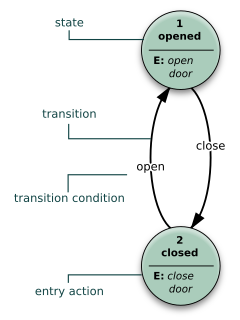
A finite-state machine (FSM) or finite-state automaton, finite automaton, or simply a state machine, is a mathematical model of computation. It is an abstract machine that can be in exactly one of a finite number of states at any given time. The FSM can change from one state to another in response to some inputs; the change from one state to another is called a transition. An FSM is defined by a list of its states, its initial state, and the inputs that trigger each transition. Finite-state machines are of two types—deterministic finite-state machines and non-deterministic finite-state machines. A deterministic finite-state machine can be constructed equivalent to any non-deterministic one.
In theoretical computer science, a nondeterministic Turing machine (NTM) is a theoretical model of computation whose governing rules specify more than one possible action when in some given situations. That is, an NTM's next state is not completely determined by its action and the current symbol it sees, unlike a deterministic Turing machine.

A triathlon is an endurance multisport race consisting of swimming, cycling, and running over various distances. Triathletes compete for fastest overall completion time, racing each segment sequentially with the time transitioning between the disciplines included. The word is of Greek origin, from τρεῖς or treis (three) and ἆθλος or athlos (competition).

Reinforcement learning (RL) is an area of machine learning concerned with how intelligent agents ought to take actions in an environment in order to maximize the notion of cumulative reward. Reinforcement learning is one of three basic machine learning paradigms, alongside supervised learning and unsupervised learning.

Automata theory is the study of abstract machines and automata, as well as the computational problems that can be solved using them. It is a theory in theoretical computer science. The word automata comes from the Greek word αὐτόματος, which means "self-acting, self-willed, self-moving". An automaton is an abstract self-propelled computing device which follows a predetermined sequence of operations automatically. An automaton with a finite number of states is called a Finite Automaton (FA) or Finite-State Machine (FSM). The figure at right illustrates a finite-state machine, which belongs to a well-known type of automaton. This automaton consists of states and transitions. As the automaton sees a symbol of input, it makes a transition to another state, according to its transition function, which takes the previous state and current input symbol as its arguments.

A state diagram is a type of diagram used in computer science and related fields to describe the behavior of systems. State diagrams require that the system described is composed of a finite number of states; sometimes, this is indeed the case, while at other times this is a reasonable abstraction. Many forms of state diagrams exist, which differ slightly and have different semantics.
In theoretical computer science, a probabilistic Turing machine is a non-deterministic Turing machine that chooses between the available transitions at each point according to some probability distribution. As a consequence, a probabilistic Turing machine can—unlike a deterministic Turing Machine—have stochastic results; that is, on a given input and instruction state machine, it may have different run times, or it may not halt at all; furthermore, it may accept an input in one execution and reject the same input in another execution.
In automata theory and sequential logic, a state-transition table is a table showing what state a finite-state machine will move to, based on the current state and other inputs. It is essentially a truth table in which the inputs include the current state along with other inputs, and the outputs include the next state along with other outputs.

In the theory of computation, a branch of theoretical computer science, a deterministic finite automaton (DFA)—also known as deterministic finite acceptor (DFA), deterministic finite-state machine (DFSM), or deterministic finite-state automaton (DFSA)—is a finite-state machine that accepts or rejects a given string of symbols, by running through a state sequence uniquely determined by the string. Deterministic refers to the uniqueness of the computation run. In search of the simplest models to capture finite-state machines, Warren McCulloch and Walter Pitts were among the first researchers to introduce a concept similar to finite automata in 1943.
In automata theory, a finite-state machine is called a deterministic finite automaton (DFA), if
In computation, a finite-state machine (FSM) is event driven if the transition from one state to another is triggered by an event or a message. This is in contrast to the parsing-theory origins of the term finite-state machine where the machine is described as consuming characters or tokens.

Area code 775 is a Nevada telephone area code in the North American Numbering Plan. It was split from area code 702 on December 12, 1998, and covers the entire state except for Clark County, which retained area code 702 after the split. Major cities in this area code include Reno, Carson City, Elko and Pahrump. While it appears to be rural, more than 80 percent of its numbers are located in the far western portion, around Reno and Carson City.
Automata-based programming is a programming paradigm in which the program or part of it is thought of as a model of a finite-state machine (FSM) or any other formal automaton. Sometimes a potentially infinite set of possible states is introduced, and such a set can have a complicated structure, not just an enumeration.

Communization mainly refers to a contemporary communist theory in which there is a mixing-up of insurrectionist anarchism, the communist ultra-left, post-autonomists, anti-political currents, groups like the Invisible Committee, as well as more explicitly ‘communizing’ currents, such as Théorie Communiste. "Obviously at the heart of the word is communism and, as the shift to communization suggests, communism as a particular activity and process..." It is important to note the big differences in perception and usage. Some groups start out from an activist voluntarism, while others derive communization as an historical and social result emerging out of capital's development over the last decades. Endnotes totally distinguishes itself from the mixing of all sorts of meanings of the word communization and explicitly refers to the different reception in the Anglophone world as opposed to the original French milieu from which it emerged as a critique.
A queue machine or queue automaton is a finite state machine with the ability to store and retrieve data from an infinite-memory queue. It is a model of computation equivalent to a Turing machine, and therefore it can process the same class of formal languages.
The president-elect of the United States is the candidate who has presumptively won the United States presidential election and is awaiting inauguration to become the president. There is no explicit indication in the U.S. Constitution as to when that person actually becomes president-elect, although the Twentieth Amendment uses the term "President-elect", thus giving the term "president-elect" constitutional justification. It is assumed the Congressional certification of votes cast by the Electoral College of the United States – occurring after the third day of January following the swearing-in of the new Congress, per provisions of the Twelfth Amendment – unambiguously confirms the successful candidate as the official ‘President-elect’ under the U.S. Constitution. As an unofficial term, president-elect has been used by the media since at least the latter half of the 19th century, and was in use by politicians since at least the 1790s. Politicians and the media have applied the term to the projected winner, even on election night, and very few who turned out to have lost have been referred to as such.
UML state machine, also known as UML statechart, is an extension of the mathematical concept of a finite automaton in computer science applications as expressed in the Unified Modeling Language (UML) notation.

In electronics, a flip-flop or latch is a circuit that has two stable states and can be used to store state information – a bistable multivibrator. The circuit can be made to change state by signals applied to one or more control inputs and will have one or two outputs. It is the basic storage element in sequential logic. Flip-flops and latches are fundamental building blocks of digital electronics systems used in computers, communications, and many other types of systems.
In computer science, a heartbeat is a periodic signal generated by hardware or software to indicate normal operation or to synchronize other parts of a computer system. Heartbeat mechanism is one of the common techniques in mission critical systems for providing high availability and fault tolerance of network services by detecting the network or systems failures of nodes or daemons which belongs to a network cluster—administered by a master server—for the purpose of automatic adaptation and rebalancing of the system by using the remaining redundant nodes on the cluster to take over the load of failed nodes for providing constant services. Usually a heartbeat is sent between machines at a regular interval in the order of seconds; a heartbeat message. If the endpoint does not receive a heartbeat for a time—usually a few heartbeat intervals—the machine that should have sent the heartbeat is assumed to have failed. Heartbeat messages are typically sent non-stop on a periodic or recurring basis from the originator's start-up until the originator's shutdown. When the destination identifies a lack of heartbeat messages during an anticipated arrival period, the destination may determine that the originator has failed, shutdown, or is generally no longer available.

The Minnesota State University Marching Band is the marching band of Minnesota State University, Mankato. The band generates enthusiasm and excitement by promoting school spirit and morale. The group performs at home football, hockey, and basketball events. The Maverick Machine consists of five ensembles including the marching band, drumline, color guard, pep band, and the indoor winds, the first collegiate WGI winds group in Minnesota.









